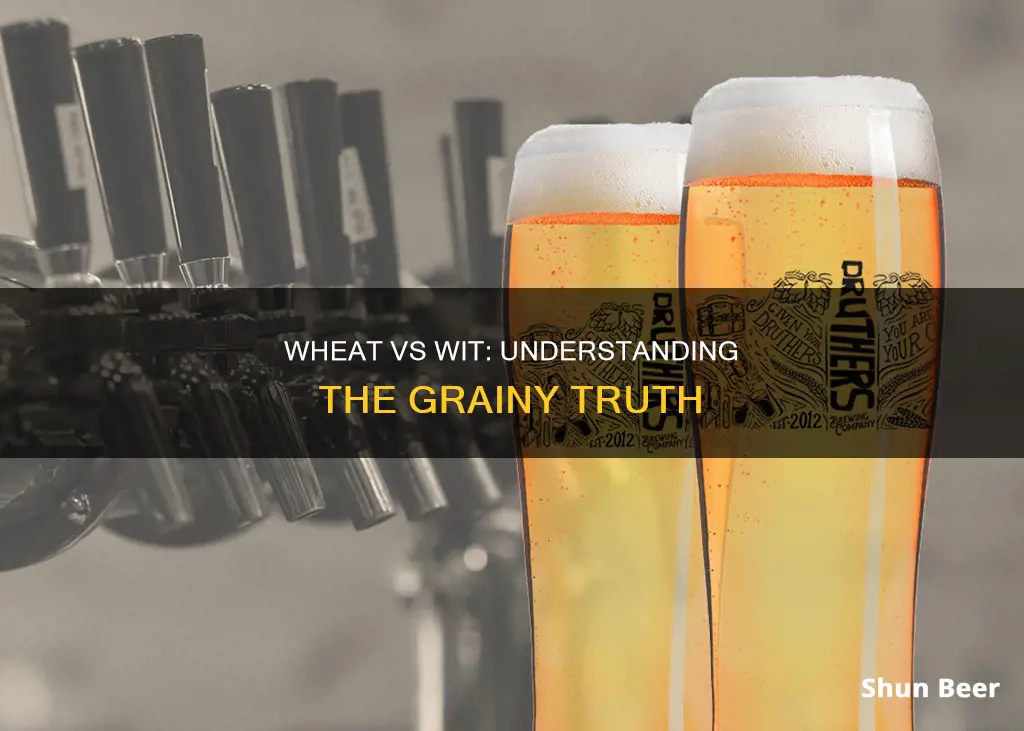
Wheat beer and witbier (wit beer) are both top-fermented beers that use a large proportion of wheat in the brewing process. However, there are some key differences between the two styles. Witbier is a Belgian-style wheat ale, also known as bière blanche in French, or white beer in Dutch/Flemish. It is traditionally brewed with unmalted wheat and spiced with coriander and orange peel, resulting in a refreshing and subtly spicy flavour profile. On the other hand, wheat beer, which includes styles such as hefeweizen and weissbier, originates from Bavaria and can be made with malted or unmalted wheat. Wheat beers are often light in colour, low to medium in alcohol content, and can be cloudy or clear. They tend to lack bitterness and are known for their fruity and spicy notes, with hints of banana and clove.
| Characteristics | Values |
|---|---|
| Name | Wheat Beer, Weizenbier, Weisse, Weizen, Hefeweizen, Weißbier, Witbier, Bière Blanche, Wit |
| Origin | Germany, Belgium, France, US |
| Main Ingredient | Wheat |
| Fermentation | Top-fermented |
| Appearance | Cloudy, Clear, Pale, Amber, Dark |
| Alcohol Content | Low to Medium |
| Bitterness | Low |
| Flavour | Banana, Clove, Coriander, Orange Peel, Bubble Gum, Vanilla, Spices, Citrus |
| Serving Temperature | 45-50°F |
What You'll Learn
- Wheat beers are typically light in colour, low to medium in alcohol content, and can be cloudy or clear
- Witbiers are cloudy, spiced with coriander and citrus, and have a refreshing, slightly spicy flavour profile
- Wheat beers originated in Bavaria, Germany, whereas witbiers are Belgian
- Wheat beers are brewed with malted or unmalted wheat, while witbiers use unmalted wheat
- Wheat beers are known for their fruity notes, while witbiers are characterised by citrus notes

Wheat beers are typically light in colour, low to medium in alcohol content, and can be cloudy or clear
Wheat beer is a category of beer that originated in Bavaria. It is typically a top-fermented ale, using at least 30% wheat in the brewing process, and comes in a variety of styles. Wheat beers are often light in colour, ranging from pale to dark, and are usually low to medium in alcohol content. They can be cloudy or clear in appearance due to the wheat proteins that can suspend in the liquid.
The most well-known wheat beer is hefeweizen, a refreshing style from Germany that is popular around the world. Hefeweizen is characterised by its cloudy appearance, fruity notes such as banana and citrus, and a slight spiciness from the yeast. It typically has low hop bitterness and relatively high carbonation.
Other styles of wheat beer include Berliner Weisse, a cloudy and sour beer that is low in alcohol content, and Witbier, a Belgian-style wheat ale that is hazy or "white" in appearance due to the suspended yeast and wheat proteins. Witbier is typically spiced with coriander and orange peel, resulting in a refreshing and slightly spicy flavour profile.
Wheat beers are generally easy to drink and pair well with a variety of dishes, making them a popular choice during warmer seasons.
Tiger Beer and Wheat: What's the Deal?
You may want to see also

Witbiers are cloudy, spiced with coriander and citrus, and have a refreshing, slightly spicy flavour profile
Wheat beer is a category of beer that originated in Bavaria. It is typically a top-fermented ale, using at least 30% wheat in the brewing process. Wheat beers are usually light in colour, low to medium in alcohol content, and can be cloudy or clear. They are often low in bitterness, making them easy to drink.
One style of wheat beer is the Witbier, or Wit for short. Wit means "white" in Dutch/Flemish and refers to Belgian-style wheat ale, or Witbier. Witbiers are cloudy, spiced with coriander and citrus, and have a refreshing, slightly spicy flavour profile.
Belgian Witbiers are brewed using unmalted wheat and spiced with coriander and orange peel. They are known for their refreshing quality and subtle spicy notes. The name "Witbier" comes from the suspended yeast and wheat proteins, which make the beer look hazy or white when cold.
Witbiers are traditionally brewed with roughly equal amounts of very pale barley malt and unmalted wheat, plus a small percentage of oats. This mix of malted and raw grains gives the beer a creamy, almost milkshake-like quality that forms the backbone of its balance. Historical styles had around 3 to 4% ABV, while modern versions are closer to 5%.
The Hoegaarden Brewery in Belgium is known for its Witbiers, and the popular American beer Blue Moon is an interpretation of this style.
Pale Ale Beer and Wheat: What's the Connection?
You may want to see also

Wheat beers originated in Bavaria, Germany, whereas witbiers are Belgian
Wheat beer and witbier (witbeer) are both types of wheat beer, but they have distinct differences. Wheat beers, also known as Weizenbier or Weizen in Germany, originated in the Bavarian region of Germany, whereas witbiers are Belgian.
Wheat Beers
Wheat beers are typically light in colour, low to medium in alcohol content, and can be cloudy or clear. They are usually top-fermented ales, though not always, and must contain a high percentage of malted or unmalted wheat. Wheat beers are known for their fruity notes, such as banana and citrus, and a slight spiciness from the yeast. The most widely known wheat beer is hefeweizen, a refreshing style from Germany that has become popular around the world.
Witbiers
Witbiers, on the other hand, are brewed with unmalted wheat and spiced with coriander and orange peel, resulting in a refreshing and slightly spicy flavour profile. Witbier is a Dutch word that translates to "white beer", and these beers are always cloudy. Witbiers are typically served in a 250ml glass, while wheat beers are usually served in a 500ml glass.
Brewing Techniques
In terms of brewing techniques, wheat beers are exceptionally hard to brew because the proteins and starches in the grain want to bind, making it tricky to extract the sugars. Witbiers, on the other hand, are traditionally made with up to 50% raw wheat rather than wheat malt, and brewers add coriander seeds and curaçao peels (bitter orange peels) during the brewing process.
Kokanee Beer: Does It Contain Wheat?
You may want to see also

Wheat beers are brewed with malted or unmalted wheat, while witbiers use unmalted wheat
Wheat beer is a category of beer that originated in Bavaria. It is typically a top-fermented ale, uses at least 30% wheat in the brewing process, and comes in a variety of styles. Wheat beers are brewed with malted or unmalted wheat. The use of wheat gives a uniquely light and refreshing profile to the beer.
One notable characteristic of wheat beer is its hazy appearance, which comes from the wheat proteins that can suspend in the liquid. The wheat proteins also contribute to the beer's foamy head. Wheat beers can range from pale to dark and offer a diverse range of flavours, including fruity and spicy notes.
The most widely known wheat beer is Hefeweizen, a refreshing style from Germany that's popular around the world. Other styles include Berliner Weisse, a cloudy and sour beer, and Gose, a sour and salty beer.
Witbier, or simply wit, is a type of wheat beer that is brewed mainly in Belgium and the Netherlands. It is a barley/wheat, top-fermented beer. Witbier uses unmalted wheat and is spiced with coriander and orange peel. The name "witbier" comes from the Dutch/Flemish word "wit", meaning "white", and refers to the hazy, white appearance of the beer when cold due to suspended yeast and wheat proteins.
Belgian witbiers are often made with raw unmalted wheat, while German wheat beers typically use malted wheat. Witbiers have a refreshing, subtle spicy flavour profile with a creamy texture.
Wheat in IPA Beer: What You Need to Know
You may want to see also

Wheat beers are known for their fruity notes, while witbiers are characterised by citrus notes
Wheat beers and witbiers are both characterised by the large proportion of wheat used in their brewing. However, they differ in their flavour profiles. Wheat beers are known for their fruity notes, while witbiers are characterised by citrus notes.
Wheat beer is a category of beer that originated in Bavaria. It is typically a top-fermented ale, using at least 30% wheat in the brewing process, and comes in a variety of styles. Wheat beers are usually light in colour, low to medium in alcohol content, and can be cloudy or clear in appearance. They tend to lack bitterness, making them easy to drink. The most well-known wheat beer is hefeweizen, a refreshing German style that is popular around the world.
The fruity notes in wheat beers come from the yeast used during fermentation. The specialised yeast strains used in wheat beers produce overtones of banana and clove, as well as bubble gum and vanilla. These fruity flavours are complemented by a light, refreshing profile that makes wheat beers easy to pair with a variety of foods.
On the other hand, witbiers are a style of wheat beer that originated in Belgium. Witbier means "white beer" in Dutch/Flemish, referring to the hazy, white appearance of the beer caused by suspended yeast and wheat proteins. Witbiers are typically brewed with coriander and citrus or other spices, such as orange peel, which complement the bready, bright wheat notes of the beer. The spices used in witbiers are subtle and should never be overpowering.
While witbiers are also top-fermented, they differ from wheat beers in the type of wheat and yeast used. Witbiers use unmalted wheat, while wheat beers use malted wheat. Witbiers also use a different yeast that does not produce the strong banana and clove flavours characteristic of wheat beers. Instead, the citrus and coriander notes in witbiers come from the addition of coriander seeds and curaçao peels during the brewing process.
Wheat Beer: What Makes Wheat Beer Unique?
You may want to see also
Frequently asked questions
Wheat beer is a category of beer that typically uses at least 30% wheat in the brewing process. It is often light in colour, low to medium in alcohol content, and can be cloudy or clear.
Witbier, or wit beer, is a variety of wheat beer that is brewed mainly in Belgium and the Netherlands. It is made with unmalted wheat and spiced with coriander, orange peel, and sometimes other spices.
Wheat beer is more of a category than a style of beer and includes several different varieties, whereas wit beer is a specific type of wheat beer. Wit beer is brewed with unmalted wheat, while wheat beer uses malted wheat. Wit beer also tends to contain less wheat than wheat beer, which influences the overall taste profile.
Some popular wheat beers include Paulaner Hefeweizen, Weihenstephaner Hefeweissbier, Franziskaner Weissbier, and Blue Moon Belgian White. Notable wit beers include Hoegaarden Witbier, Allagash White, and Wittekerke.







